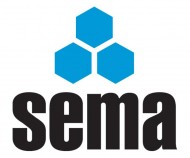Our first question this month looks at the validity of the securing of frames to a building or wall and the second looks at racking pins and how they should be used to best effect.
 Securing of Frames
Securing of Frames
Q I have a client who is insistent on securing frames to the main infrastructure of the building, in his view to prevent collapse. Could I have SEMA’s views on this as I can see nothing in the guides or ACOPs which would give a definitive answer?
A There are some basic geometrical rules based on the height to width ratio that are used within the SEMA codes. If the height of the rack to the top beam level divided by the frame depth is less than 10 and each rack foot is bolted to the floor then the rack is designed as free standing. So for example a rack with a beam height of 10m and frame depth of 1.1m has ratio of 9.09. If however this ratio exceeds 10 then the rack need to be tied to another structure. This is generally achieved by tying to an adjacent run of back to back racking which has run spacers connecting the two runs together. If this is not possible then the only options are to tie across the top of an aisle to an adjacent rack or to tie back to the building structure.
The Storage Equipment Manufacturer’s Association User’s Guide for Pallet Racking in section 7.2 provides guidance as follows
7.20 Ties to Buildings
Restraining ties to the building structure are not recommended. However, if ties are fitted, the User should confirm with the Supplier that the ties have been correctly designed and installed.
When such ties are required, checks should be made that the loads transmitted through the ties are within the safe capacity of the building structure and the racking.
This advice is essentially repeated in the Health and Safety Executive publication HSG76 Warehouse and Storage a Guide to Health and Safety paragraph 634 where there is a requirement for the building structure to be “proved” that that it has been designed to accommodate the forces from the racking system.
It is not just a case of designing the building for the loads but also the racking designer will need to be made aware of the tie and the forces that will be transmitted in to the racking from the building naturally moves under loading. The allowable deflections in building design are generally far higher than those used in the design of pallet racking structures.
Locking Pin Guidance
Q Would you be able to provide me with guidance with regards to the use of locking pins that are placed in the connectors of horizontal beams?
A The SEMA Guidance is to provide locking pins or ‘beam connector locks’ as they are officially called when pallet racking is used to store pallets (or similar large loads) which are placed in the rack using mechanical handling equipment. The pins are provided to reduce the risk of accidental beam dislodgement should the beam be accidentally lifted which might cause it to be dislodged from the upright or cause serious damage to the upright. These pins are there to provide a ‘fuse’ effect in the event that the beam dislodges from the upright before such a large force is transferred to the upright that it too is destroyed. In such an event the accident is hopefully restricted to a single pair of beams and not a complete bay or series of bays in a run being destroyed.
If the pallet racking system is being used as a shelving system and the levels are loaded by hand then there is no requirement to fit beam connector locks. The forces exerted in hand operations are not normally great enough to dislodge a beam even if it does not have connector locks fitted.
It is difficult to tell from the photos you have supplied as to the full operation of the system. From the second photo it looks as if there is pallet storage on the building floor slab under the rack and given the first beam level has a chipboard deck and is probably hand loaded It may be that this is a combination of mechanical and hand loading. If this is the case the first level beam could be at risk from a pallet being lifted too high by a fork truck or the top of the back guard of the forks catching under the first beam and this level should therefore be fitted with beam connector locks as a minimum.
SEMA is delighted to be working with WLN on the storage Question and Answer Column. On the WLN website is a list of previously published columns.
SEMA Annual Safety Conference 2014 – a date for your diary: The 2014 SEMA Safety Conference is on Thursday, 6 November; at the National Motorcycle Museum, Solihull. For details contact enquiry@sema.org.uk
SEMA Technical Enquiries: If you have a query send it to us and we will do our best to have it answered.
SEMA Rack Safety Awareness and Inspection Courses: SEMA runs a one-day safety course on Rack Safety Awareness and Inspection. These courses are aimed at end users, giving an in-depth look at the need for inspections, how to conduct an assessment and what actions to take when this is completed.
SEMA Approved Rack Inspectors Qualification: This qualification is aimed at professionals who conduct rack surveys as an integral and significant part of their duties. It involves delegates in undertaking an in-depth SEMA Course, together with an examination and practical assessment.




Comments are closed.